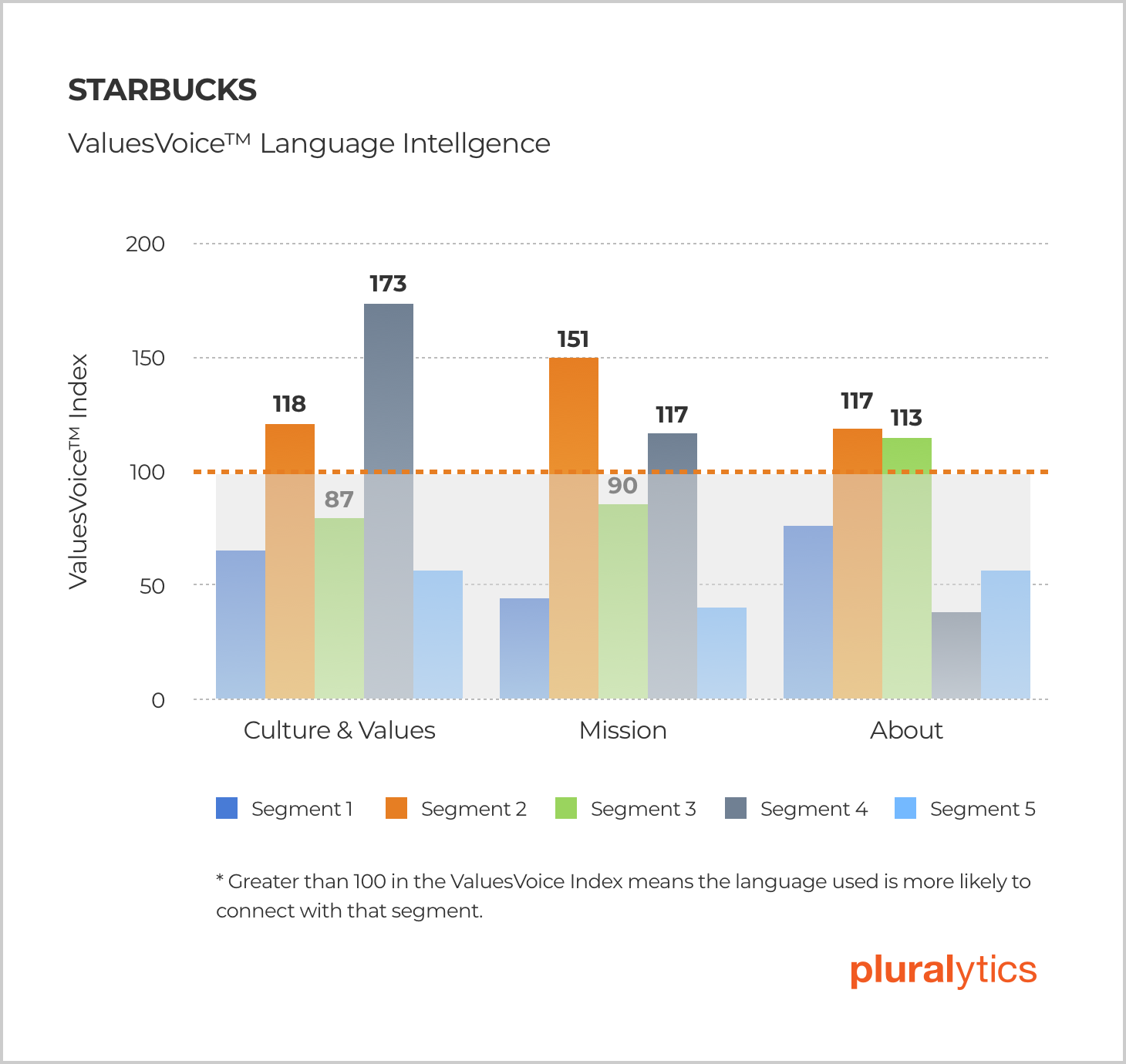
Why what Steve Jobs said in 1997 is more relevant than ever.
July 2021
The Pluralytics Language Analyst Group
How deeply you connect with your customers is make or break for any business. When marketers go through the process of defining brand voice, they dimension three elements with their target audience in mind: values, tone, and style. A well-defined and executed brand voice combined with a compelling visual identity are the foundational elements of a unique brand personality that is the hallmark of the most successful brands. Marketers also know that consistency is king when it comes to generating engagement, the primary driver of ROI across platforms: website, content marketing, and social. Clear brand messaging that engages target customers and current customers delivers improvement in vital metrics: conversion (CAC), loyalty, churn, revenue per customer, and LTV.
The most effective brand messaging conveys a product’s unique value proposition and connects with consumers in a relatable, inspiring, and persuasive way. Conny Braams, Chief Digital & Marketing Officer for consumer goods giant Unilever has said that customers make decisions about brands not just for their value proposition but also for their values. Braams’ take is noteworthy considering Unilever’s vast portfolio of brands, including purpose-driven standouts like Ben & Jerry’s and Dove. Unilever has become a leader in exploring the role of purpose in positioning and brand messaging, which is significant since it regularly ranks as one of the largest and most influential advertisers in the world with an annual brand investment of around $8 billion.
When it comes to brand building, purpose and values are closely related elements and have gone from nice-to-have to must-have considerations for businesses of all sizes when developing a brand messaging framework. Why? Today, more than 50% of consumers factor in values when making a purchasing decision and that number grows to more than 70% for Millennials and GenZ. Values and values alignment are primary elements of effective brand messaging that deepen connection and drive critical engagement.
The strongest brand messaging stays true to the look, feel, and voice of the brand, while adhering to values as guiding principles. Well-articulated brand values with consistent presence in messaging create powerful bonds with customers that result in brand loyalty.
As an example, multinational coffee chain Starbucks has a defined set of values on the Culture and Values page of its website. The company expresses its values in a highly relatable way: “creating a culture of warmth and belonging, where everyone is welcome,” and “being present, connecting with transparency, dignity, and respect.” It is easy to see how the company’s values connect to its in-store execution where it creates safe, welcoming spaces for coffee lovers. As a customer, you know what you are going to get when stepping into a Starbucks, no matter where you are in the world. Howard Schultz, the company’s chairman emeritus and former CEO, described the company in language that echoes those articulated corporate values, famously saying: “We’re in the business of human connection and humanity, creating communities in a third-place between home and work.”

Shultz’s comments are an example of the kind of messaging consistency that brand managers and communicators know is vital to maintaining a strong brand identity. Analysis of key pages on the Starbucks website — Culture & Values, Mission and About — using Pluralytics’ ValuesFinder™ language intelligence platform shows that consistency of Starbucks’ values signaling in action. Our machine learning platform uncovers what values a brand conveys across nearly every word it chooses. We use a combination of behavioral and linguistic science, not previously available, to identify values signals and to help brands know whether their content resonates with the values of their stakeholders. In Starbucks’ case, these pages consistently speak to people who value achievement, self-expression, “seek to influence others” and have a “global worldview.” And they are more likely to care about the environment. Sound like a Starbucks customer you know?
A brand identity is more than just a color palette or slogan, but rather the sum of how a brand feels, looks, and speaks to its target audiences. Almost every word expresses values and an opportunity to connect with or disconnect from your stakeholders. A strong brand identity will give a business a competitive edge. An inconsistent brand voice is an undeniable liability.
Another best-in-class example that fully embodies its brand identity is Apple. The company’s brand positioning is designed to induce emotion. The Apple product experience, which leverages a design aesthetic of elegance and minimalism, is intended to fuel our aspirational thinking and power our dreams. It asks us to consider our own potential: where can my spirit of innovation take me? From the brand’s crisp white packaging, its futuristic Apple Park headquarters, and trend-setting product design, Apple embodies its brand identity in every aspect of its business. By letting the products speak through design, the brand leaves space for their customers to consider being more: to create; to connect with each other; to set and achieve lofty goals. Apple’s brand identity is extraordinarily powerful, which has made Apple not only one of the most recognized brands on the planet but has catapulted it to be the biggest company in the world by market capitalization.
Whether you’re a small business owner or the brand manager at a Fortune 500, crafting clear and compelling brand messages across platforms at scale isn’t easy. In fact, in a recent study, marketers admitted that nearly 40% of content generated was likely off-brand. It can seem almost impossible to maintain consistency of brand voice in the haze of serving a diverse social media following, the unforgiving and opaque formulas that drive SEO, and the relentless drive to generate conversions. But without a well-thought-out brand messaging framework, all other communications can become untethered from those core brand values that customers and stakeholders demand.
In 1997, when launching the “Think Differently” marketing campaign, Steve Jobs said: “To me, marketing is about values. This is a very complicated world; it’s a very noisy world. And we’re not going to get a chance to get people to remember much about us. No company is. And so we have to be really clear on what we want them to know about us.”
Almost 25 years later Jobs’ words still ring true. In today’s noisy and tumultuous world, marketing is about values more than ever before and ensuring your brand’s clarity of voice, consistency, and resonance will be the difference between failure and success.
Don’t leave brand messaging to guesswork and gut instinct. Leverage the power of AI to have confidence your brand is connecting with your customers every time. Pluralytics helps companies build deep connections, understand language with scientific precision, and hit the mark in every communication.
Build meaningful connections anytime, anywhere. That’s the power of Pluralytics.
Start a Free 30 day trial